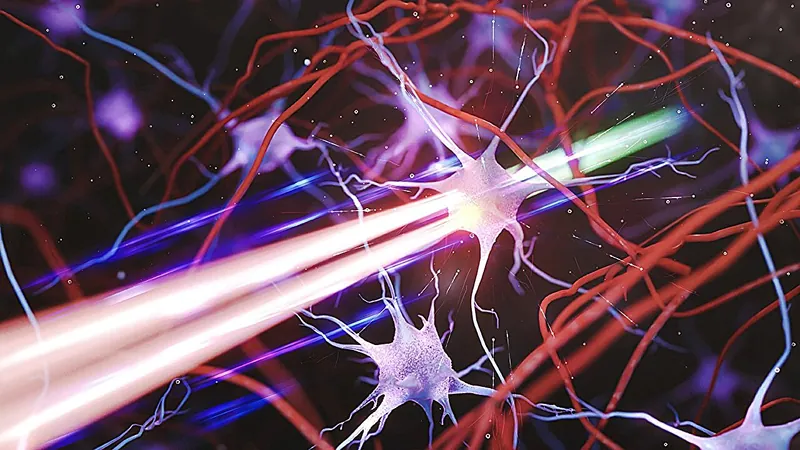
Breakthrough in Neuroscience: New DEEPscope Microscope Revolutionizes Brain Imaging!
2024-11-06
Author: Olivia
Introduction
In an exciting leap for neuroscience, researchers at Cornell University have introduced a groundbreaking imaging technology known as DEEPscope, which allows for unprecedented deep and wide-field visualization of brain activity at an astonishing single-cell resolution. This innovative microscope merges cutting-edge two-photon and three-photon microscopy techniques, enabling scientists to explore large-scale neural activity and intricate structural details of the brain that were once thought to be out of reach.
Limitations of Traditional Techniques
Traditional multiphoton microscopy has long been the go-to method for deep-tissue imaging, yet it struggles with significant limitations related to imaging depth and the field of view—particularly in densely scattering biological tissues like the brain. Typically, as imaging depth is increased, the field of view shrinks dramatically, hindering the ability to observe extensive neuronal networks effectively. DEEPscope combats these challenges by implementing a suite of novel techniques, allowing researchers to visualize extensive brain regions at unprecedented depths while maintaining clarity.
Key Features of DEEPscope
A hallmark of this groundbreaking advancement is DEEPscope's adaptive excitation system paired with a multi-focus polygon scanning scheme. These innovations facilitate efficient fluorescence generation over a large field of view, achieving high-resolution imaging across an area of 3.23 x 3.23 mm². Remarkably, DEEPscope operates with an imaging speed suitable for capturing neuronal activity deep within the cortical layers of mouse brains, setting it apart from existing technologies.
Imaging Capabilities
Notably, DEEPscope enhances its versatility through simultaneous two-photon and three-photon imaging capabilities, providing researchers with the ability to meticulously explore both superficial and deep brain regions. In a recent study published in the prestigious journal eLight, the team demonstrated the impressive capabilities of DEEPscope by imaging entire cortical columns and various subcortical structures with unrivaled single-cell resolution. They successfully tracked neuronal activities across more than 4,500 neurons in both shallow and deep cortical layers of transgenic mice.
Applications Beyond Mice
The microscope’s applications extend beyond mice. Researchers comfortably accomplished whole-brain imaging of adult zebrafish, capturing intricate structural details at depths surpassing 1 mm and across a field wider than 3 mm—setting a new benchmark in the field of neuroscience.
Significance and Future Implications
Lead study author Aaron Mok emphasized the significance of this advancement, stating, 'DEEPscope represents a monumental shift in brain imaging technology. For the first time, we can visualize complex neural circuits in living animals on such an expansive scale and depth. This innovation not only enhances our understanding of brain functionality but also opens new avenues for neurological research.'
Integration with Existing Technologies
Another exciting aspect of DEEPscope is its potential for integration with existing multiphoton microscopes. By incorporating these new techniques, this technology promises to be a game-changer across various scientific disciplines where deep-tissue imaging is essential. With its ability to transcend previous limitations, DEEPscope establishes a new gold standard for large-field, high-resolution imaging of living tissues, advancing our understanding of the brain's complex networks and their roles in health and disease.
Conclusion
The implications of this cutting-edge technology could significantly impact research areas including neurodegenerative diseases, mental health disorders, and overall brain functionality. As experts eagerly await further applications of DEEPscope, one thing is clear: the future of brain imaging is brighter than ever!









 Brasil (PT)
Brasil (PT)
 Canada (EN)
Canada (EN)
 Chile (ES)
Chile (ES)
 España (ES)
España (ES)
 France (FR)
France (FR)
 Hong Kong (EN)
Hong Kong (EN)
 Italia (IT)
Italia (IT)
 日本 (JA)
日本 (JA)
 Magyarország (HU)
Magyarország (HU)
 Norge (NO)
Norge (NO)
 Polska (PL)
Polska (PL)
 Schweiz (DE)
Schweiz (DE)
 Singapore (EN)
Singapore (EN)
 Sverige (SV)
Sverige (SV)
 Suomi (FI)
Suomi (FI)
 Türkiye (TR)
Türkiye (TR)